DOWNLOADS
Dosha Parihara
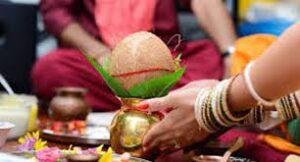 Parihara means, it’s a set of actions that needs to be performed in order to remove or reduce the ill effects of doshas that are caused because of the positions of the Planets in ones’ horoscope. Each dosha has its own set of Parihara (i.e.) the type of Parihara to be done depends on of the type of Dosha in the horoscope.
Parihara means, it’s a set of actions that needs to be performed in order to remove or reduce the ill effects of doshas that are caused because of the positions of the Planets in ones’ horoscope. Each dosha has its own set of Parihara (i.e.) the type of Parihara to be done depends on of the type of Dosha in the horoscope.
Indians have a strong belief in God and so whenever we face any problem or any issue, we visit a lot of Parihara sthalams and we seek the blessings of God by doing the Parihara. Here is the list of some of the Personalised Parihara Trips Package that is offered depending upon the requirements of various customers.
Kukke Subramanyais a Hindu temple located in the village of Subramanya, Karnataka. Here, Kartikeya is worshipped as Subramanya, lord of all serpents.
Distance:280 Km From Banglore
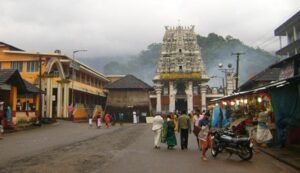 According to one Mythological story, after killing the demon rulers, Tharaka, Shurapadmasura and their followers in a war, Lord Shanmukha reached Kumara parvatha with his brother Ganesh and others. He was received by Indra and his followers. Indra being very happy prayed Lord Kumara Swamy to accept and marry his daughter Devasena for which the Lord readily agreed. The divine marriage took place on Margashira shudha shashti at Kumara parvatha. Gods like Brahma, Vishnu, Rudra and many other deities assembled for the marriage and coronation ceremony of Shanmukha, for which waters of several holy rivers were brought. With these waters of Mahabhisheka fell down to form a river which was later known by the popular name Kumaradhara.The great Shiva Bhakta and Serpent king Vasuki was performing tapas for years in the Biladwara caves of Kukke Subrahmanya to avoid the attack of Garuda. Following Lord Shiva`s assurance, Shanmuka gave darshan to Vasuki and blessed him that he would stay with his parama bhakta in this place forever. Hence, the poojas offered to Vasuki or Nagaraja are nothing but the poojas to Lord Subrahmanya.
According to one Mythological story, after killing the demon rulers, Tharaka, Shurapadmasura and their followers in a war, Lord Shanmukha reached Kumara parvatha with his brother Ganesh and others. He was received by Indra and his followers. Indra being very happy prayed Lord Kumara Swamy to accept and marry his daughter Devasena for which the Lord readily agreed. The divine marriage took place on Margashira shudha shashti at Kumara parvatha. Gods like Brahma, Vishnu, Rudra and many other deities assembled for the marriage and coronation ceremony of Shanmukha, for which waters of several holy rivers were brought. With these waters of Mahabhisheka fell down to form a river which was later known by the popular name Kumaradhara.The great Shiva Bhakta and Serpent king Vasuki was performing tapas for years in the Biladwara caves of Kukke Subrahmanya to avoid the attack of Garuda. Following Lord Shiva`s assurance, Shanmuka gave darshan to Vasuki and blessed him that he would stay with his parama bhakta in this place forever. Hence, the poojas offered to Vasuki or Nagaraja are nothing but the poojas to Lord Subrahmanya.
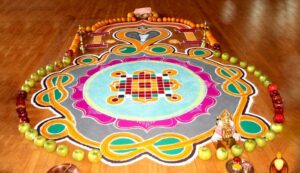 Sarpa Dosha is one of the poojas performed at Kukke Subramanya Temple by devotees to get rid of the sarpa dosha. According to belief, a person either in this birth or any of his previous births can be afflicted by the sarpa (serpent) dosha (curse) either knowingly or un-knowingly through many ways. Persons who are afflicted with this dosha are advised by the astrologers /horoscope writers to perform this pooja for their well being. Pooja can be done either by the person afflicted if he is a male and married, or through a priest. This is because the pooja involves rituals similar to the ones done in performing shrartham (death rites). Sarpa Samskara seva devotees are required to stay for two days. The seva occurs in the day time with no particular poojas in the evening. Food arrangements will be provided to the said devotees by the temple devastanam, for four persons only per seva.
Sarpa Dosha is one of the poojas performed at Kukke Subramanya Temple by devotees to get rid of the sarpa dosha. According to belief, a person either in this birth or any of his previous births can be afflicted by the sarpa (serpent) dosha (curse) either knowingly or un-knowingly through many ways. Persons who are afflicted with this dosha are advised by the astrologers /horoscope writers to perform this pooja for their well being. Pooja can be done either by the person afflicted if he is a male and married, or through a priest. This is because the pooja involves rituals similar to the ones done in performing shrartham (death rites). Sarpa Samskara seva devotees are required to stay for two days. The seva occurs in the day time with no particular poojas in the evening. Food arrangements will be provided to the said devotees by the temple devastanam, for four persons only per seva.
Angapradakshinam is a kind of Prayer offered by Pilgrims where they lie prostrate and then roll around the temple with wet clothes.
Due to the wide belief in the snake god in the coastal regions of Karnataka and Kerala, this pooja is performed by people from all faiths.
Purpose, Benefits & Uses of Doing Sarpa Samskara
Sarpa Samskara Pooja is generally suggested for unmarried people. Sarpa Dosham is generally believed to be the result of misdeeds from a past life/lives revisiting your present life. If your atma (soul) has caused any harm to snakes in a prior life, then it will cause problems for you in this life, hence 'sarpa dosham'. To obtain relief from 'Sarpa Dosham' you need to perfom 'sarpa samskara'. The cost of a 'sarpa samskara' ranges from Rs.1300 to Rs.1800.
Mookambika temple is located at Kollur in Karnataka. It is the only temple that is dedicated to Parvathi and is believed to have been created by Parashurama. This temple is well known among the people of Tamil Nadu and is called Thai Mookambika in Tamil. The temple is located exactly on the banks of the perennial river Souparnika.
Distance:434 Km from Banglore
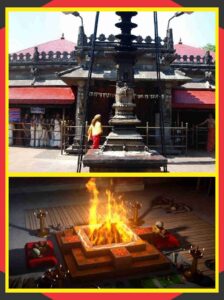 Mookambika temple is located at Kollur in Karnataka. It is the only temple that is dedicated to Parvathi and is believed to have been created by Parashurama. This temple is well known among the people of Tamil Nadu and is called Thai Mookambika in Tamil. The temple is located exactly on the banks of the perennial river Souparnika.
Mookambika temple is located at Kollur in Karnataka. It is the only temple that is dedicated to Parvathi and is believed to have been created by Parashurama. This temple is well known among the people of Tamil Nadu and is called Thai Mookambika in Tamil. The temple is located exactly on the banks of the perennial river Souparnika.
Devi Mookambika has three eyes and four arms, with the divine disc and conch in each of her hands. The Mookambika temple is renowned for its beauty and aesthetics, all over the world. Goddess Kollur Mookambika is adorned with flowers. Ritual bathing and prayer to the idol are a common feature of the presiding lingam. Water from Souparnika river is used for theertham and puja.
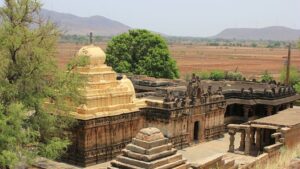 Located at a distance of 70 km from Davanagere, the village of Agasanahalli has a temple built for Lord Narasimha, in the form of Lord Subramanya. This is a very ancient temple and the history of the temple dates back to the age of saint Agastya who had once visited this village and performed penance. Hence, the village is named Agasanahalli. The sanctum sanctorum has an anthill with the image of Lord Narasimha—naturally formed—which is worshipped here. A lot of devotees flock in to seek blessings on no moon days and a car festival is celebrated with great devotion every once a year. The temple complex also has a shrine built for hanuman.
Located at a distance of 70 km from Davanagere, the village of Agasanahalli has a temple built for Lord Narasimha, in the form of Lord Subramanya. This is a very ancient temple and the history of the temple dates back to the age of saint Agastya who had once visited this village and performed penance. Hence, the village is named Agasanahalli. The sanctum sanctorum has an anthill with the image of Lord Narasimha—naturally formed—which is worshipped here. A lot of devotees flock in to seek blessings on no moon days and a car festival is celebrated with great devotion every once a year. The temple complex also has a shrine built for hanuman.
Situated in Chittoor, Srikalahasti Temple is popular among devotees who visit the temple along with the highly revered Tirupati Temple, which is just 36 km away. Dedicated to Lord Shiva, Kalahasti temple has immense religious importance for Hindus and was constructed in the year 1516 by Krishnadevraya, a king of the Vijayanagara Empire.
The elaborate structure of the Srikalahasti temple complex is a breathtaking view right from the entrance. It has intricate carvings of numerous mythological illustrations that one can explore in the divine surroundings. This magnificent temple is often referred to as the Kailasa and Kashi of the south. The temple represents one of the five elements (Pancha Bhoota) - Air or Vayu.
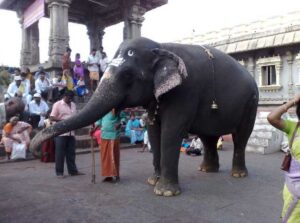 The place has an abundance of vibrant, divine aura and has the potential to draw visitors with its ornate shrines and mesmerising beauty. Srikalahasti is an excellent example of South Indian temple architecture where highly ornamented gopurams with expansive intricately carved interiors unfold the magnificent treasures of the Dravidian style of architecture. The name Srikalahasti was derived from a myth that stated that a Spider (Sri), a Snake (Kala) and an Elephant (Hasti) worshipped Lord Shiva in the town to attain Moksha. The core of this mythology was considered a sign by many religious believers and hence, in the 5th Century during the Pallava period, the Srikalahasti Temple was built.
The place has an abundance of vibrant, divine aura and has the potential to draw visitors with its ornate shrines and mesmerising beauty. Srikalahasti is an excellent example of South Indian temple architecture where highly ornamented gopurams with expansive intricately carved interiors unfold the magnificent treasures of the Dravidian style of architecture. The name Srikalahasti was derived from a myth that stated that a Spider (Sri), a Snake (Kala) and an Elephant (Hasti) worshipped Lord Shiva in the town to attain Moksha. The core of this mythology was considered a sign by many religious believers and hence, in the 5th Century during the Pallava period, the Srikalahasti Temple was built.
Source Further expansion of the temple complex, renovations and some latest structures were built during the reign of the Chola Kingdom during the 11th Century and Vijayanagara Dynasty during the 16th Century. The works of a Tamil Poet, Nakkeerar, have references to the temple proving its existence during the Tamil Sangam Dynasty. Nakkeerar and another famous Telugu Poet, Dhoorjati, wrote numerous stanzas in praise of Srikalahasteeswara.
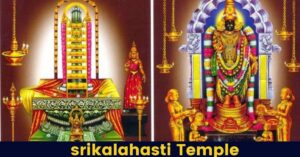 Srikalahasti Temple Pooja Timings and Cost
Srikalahasti Temple Pooja Timings and Cost
•Temple Abhishekam - 6:00 AM, 7:00 AM, 10:00 AM and 5:00
PM, Monday to Sunday - INR 600.
Subhrata Seva - INR 50
Archana - INR 25
Gomatha Pooja - INR 50
Sahasranamarchana - INR 200
Trisathi Archana - INR 125
Rahu Ketu Pooja - 6:00 AM to 6:00 PM, Monday to Sunday - INR 500
Kaal Sarpa Nirvana Pooja - 6:00 AM to 6:00 PM, Monday to Sunday - INR 750
Aseervachana Rahu Ketu Kaal Sarpa Nirvana Pooja - 6:00 AM to 6:00 PM - INR 1500
Special Aseervachana Rahu Ketu Kaal Sarpa Nirvana Pooja - 6:00 AM to 6:00 PM - INR 2500
Tips For Visiting Srikalahasti Temple
1.Do not purchase pooja materials from the stalls outside the temple. You are given all the materials that are needed for the pooja Along with INR 1000 ticket. This ticket also entitles you to an exclusive darshan (glimpse) and archana (special pooja) of the main deities within the temple.
2.Don't forget to see the Pathala Ganapathi underground temple located in the temple complex.
3.Take care if you are in the main sanctum of the temple where the deity is as it is dark and full of roaches. Priests demand money for every statue or thing they show.
4.Certain Dosha Poojas could have a dress code; please check at the ticket counter in advance. These Poojas are also instructed in Tamil, Telugu and English.
5.For darshan, ensure you wear conservative clothing.
Thirunageswaram Sri Naganathaswamy Temple is the very famous Rahu Stalam in Tamil Nadu, dedicated to Lord Rahu. Rahu Bhagavan is worshipped at this temple along with his two consorts Nagakanni and Nagavalli. Usually, in other temples, Rahu Bhagavan is seen with a serpent face but here, at Sri Naganathaswamy Temple, Lord Rahu is seen with a human face which is its unique feature.
The presiding deity of Sri Naganathaswamy Temple is lord shiva who is worshipped as Lord Naganathaswamy and represented by the Lingam. His consort, Goddess Parvathi is depicted as Giri Gujambika with Goddess Lakshmi and Goddess Saraswathy by her side. A fascinating aspect of Sri Naganathaswamy Temple is that during milk Abhishekam, the milk when poured over the idol of Lord Rahu turns Blue and is considered to be a miracle that attracts a lot of devotees from distant places.
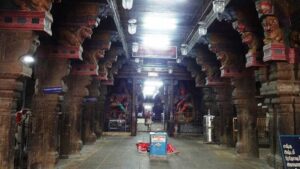 Visiting Rahu Stalam, Sri Naganathaswamy Temple, Thirunageswaram in Tamilnadu, dedicated to Rahu Bhagavan is considered very auspicious to diminish the malefic effect of Rahu. Rahu Bhagwan is believed to be the cause for one’s good position, business, status, winning over opposition, faithfulness, to travel overseas, and for mantra power. As per the ancient science of Astrology, Rahu is considered a shadow planet which means it has no real physical existence.
Visiting Rahu Stalam, Sri Naganathaswamy Temple, Thirunageswaram in Tamilnadu, dedicated to Rahu Bhagavan is considered very auspicious to diminish the malefic effect of Rahu. Rahu Bhagwan is believed to be the cause for one’s good position, business, status, winning over opposition, faithfulness, to travel overseas, and for mantra power. As per the ancient science of Astrology, Rahu is considered a shadow planet which means it has no real physical existence.
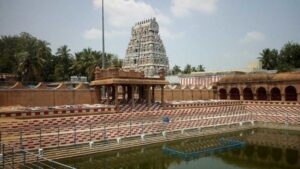 Anyhow, its malefic influence is very powerful, and its presence is said to make the lives of natives burdensome. It is believed that the presence of Rahu in one’s horoscope signifies karma bondage coming down from their previous births. Puthira Dosham, Kalathra Dosham, Sarpa Dosham, mental disorders, communicable diseases, leprosy, delay in getting married, childlessness, troublesome married life, and fall in grace are caused by Rahu Dosham.
Anyhow, its malefic influence is very powerful, and its presence is said to make the lives of natives burdensome. It is believed that the presence of Rahu in one’s horoscope signifies karma bondage coming down from their previous births. Puthira Dosham, Kalathra Dosham, Sarpa Dosham, mental disorders, communicable diseases, leprosy, delay in getting married, childlessness, troublesome married life, and fall in grace are caused by Rahu Dosham.
Praying to Rahu Bhagavan at this Rahu Stalam helps to rid a person from these Doshams and also saves the person from all poisonous life forms. Hence, devotees who are badly affected by Rahu can be seen flocking Sri Naganathaswamy Temple to offer prayers and seek the blessings of Rahu Bhagavan.
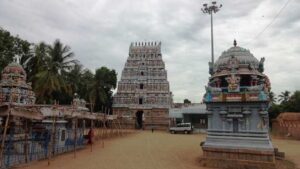 Astrologers suggest that doing Milk Abhishekam for Rahu Bhagavan during Rahu Kalam, especially on Sundays at Sri Naganathaswamy Temple can neutralize the malefic effect of Rahu like marriage obstacles, lack of progeny, Puthira Dosham, Kaalasarpa Dosham, Kalathra Dosham, and Sarpa Dosham. It is also suggested that reciting Rahu Moola Manthra and Rahu Gayatri Manthra also helps alleviate the malefic effect of Rahu. It is a miracle that during Milk Abhishekam, the milk poured over the idol of Lord Rahu turns Blue. Urad Dal and Blue Cloth are the main offerings of Sri Naganathaswamy Temple. Also, Mantharai Flower is considered very special to Rahu Bhagav
Astrologers suggest that doing Milk Abhishekam for Rahu Bhagavan during Rahu Kalam, especially on Sundays at Sri Naganathaswamy Temple can neutralize the malefic effect of Rahu like marriage obstacles, lack of progeny, Puthira Dosham, Kaalasarpa Dosham, Kalathra Dosham, and Sarpa Dosham. It is also suggested that reciting Rahu Moola Manthra and Rahu Gayatri Manthra also helps alleviate the malefic effect of Rahu. It is a miracle that during Milk Abhishekam, the milk poured over the idol of Lord Rahu turns Blue. Urad Dal and Blue Cloth are the main offerings of Sri Naganathaswamy Temple. Also, Mantharai Flower is considered very special to Rahu Bhagav
‘Parasurama Kshetra’. With thousands of people visiting the temple every year; the temple is amongst the most popular Hindu temples in Southern India. It is devoted to the deity Bhagavathy who is worshipped as Goddess Saraswati in the morning, Goddess Lakshmi in the day, and Durga during the evening. The Goddess Bhagavathy here is also portrayed with the discus and conch – traditional arms that are believed to be wielded by Lord Vishnu. The Goddess depicts all A glorious temple of God’s Own Country, Kerala – the Chottanikkara Temple is situated at three avatars of Shakti and when you move towards Chottanikkara Bhagavathy Temple from Ernakulam, you will hear the echo of people chanting “Amme Narayana, Devi Narayana, Lakshmi Narayana, Bhadre Narayana” from every direction.
Chottanikkara Temple History
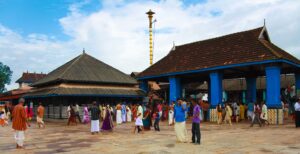 The temple is believed to be around 1500 years old and was built by a forest occupant named Kannappan. He loved his little daughter. To protect her from evil spirits, he started to sacrifice an animal every day to the Goddess Bhagavathy but one day he was unable to find any animal to sacrifice. He requested his daughter to give her pet calf for sacrifice but she refused saying he’d rather sacrifice her own life for the goddess. The calf spoke to Kannappan and revealed that it was the Goddess in an animal avatar. After that Kannappan started to worship her at the place where they sacrificed the animals. The shrine was abandoned and later was found by a grass-cutter.
The temple is believed to be around 1500 years old and was built by a forest occupant named Kannappan. He loved his little daughter. To protect her from evil spirits, he started to sacrifice an animal every day to the Goddess Bhagavathy but one day he was unable to find any animal to sacrifice. He requested his daughter to give her pet calf for sacrifice but she refused saying he’d rather sacrifice her own life for the goddess. The calf spoke to Kannappan and revealed that it was the Goddess in an animal avatar. After that Kannappan started to worship her at the place where they sacrificed the animals. The shrine was abandoned and later was found by a grass-cutter.
Dress Code at Chottanikkara Temple
Men are required to take off their shirts before entering the temple. Ladies need to be dressed in either salwar suit or sarees to enter the temple.
Mannarasala Sree Nagaraja Temple is a very ancient temple which is located near Harippad in the Alappuzha or Alleppey district of Kerala. The Mannarasala Nagaraja Temple is an internationally renowned temple dedicated to Nagaraja, the serpent god. Its beautiful setting amidst dense green forest grove creates a tranquil and eco-friendly ambiance all around. This divine shrine is under the support of a Brahmin family. And unlike other temples in the country, Mannarasala Temple is headed by a priestess whom the devotees fondly call as Mannarasala Amma. It is said that the deity of this shrine is blessed with the spirit of Lord Shiva and has the form of Lord Vishnu.
The temple is adorned with over thirty thousand paintings and drawings of snakes all along the paths crisscrossing the serene forest area. Mannarasala Temple is often visited by swarms of devotees from far and near to offer prayers to the serpent god, Nagaraja.
The lively and exotic temple festivals of Kerala are too surprising and experiential offer you a chance to delve into the vivid culture and tradition of the state. Kerala’s rich culture and heritage justify why it is so-called the “God’s Own Country”.
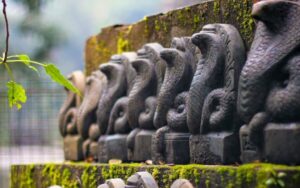 The history of Mannarasala Nagaraja Temple is closely associated with Lord Parasurama who is believed to be the creator of Kerala. Legend has it that Parasurama threw his axe into the sea and thus raised the land from the sea, known as Kerala. He then gifted the land to the Brahmins. But the land was not habitable because of the high concentration of salt which led them to leave the place. Parasurama, who was deeply saddened by this, decided to start a penance to please Lord Shiva, who in turn ordered him to worship Nagaraja. Lord Nagaraja, being pleased with Parasurama’s penance, appeared before him to bless him with a desalinated land and also granted his eternal presence in Kerala. Thus, Nagaraja decided to reside at that place and bless its residents as per the wish of Parasurama.
The history of Mannarasala Nagaraja Temple is closely associated with Lord Parasurama who is believed to be the creator of Kerala. Legend has it that Parasurama threw his axe into the sea and thus raised the land from the sea, known as Kerala. He then gifted the land to the Brahmins. But the land was not habitable because of the high concentration of salt which led them to leave the place. Parasurama, who was deeply saddened by this, decided to start a penance to please Lord Shiva, who in turn ordered him to worship Nagaraja. Lord Nagaraja, being pleased with Parasurama’s penance, appeared before him to bless him with a desalinated land and also granted his eternal presence in Kerala. Thus, Nagaraja decided to reside at that place and bless its residents as per the wish of Parasurama.
Legend says that a Brahmin couple named Vasudeva and Sreedevi who were childless, resolutely worshipped for a child. An unexpected fire broke out in the forest during that time, around the dwelling place of Nagaraja. The forest was burnt down and the serpents were badly burnt by the flame. The couples, Vasudeva and Sreedevi took care of the wounded serpents, they poured ghee mixed with honey and oil on the wounds and cooled their melted bodies with sandalwood paste and comforted them. The serpents were put back at the foot of the banyan trees and new pits were also constructed for them to reside when they regained their health. The couples conducted elaborate poojas and offered a mixture of ghee, milk, Payasam, rice powder, turmeric powder, coconut juice, bananas, cow’s milk to the Nagaraja as a ritual. This ritual is still observed in the Mannarasala Nagaraja Temple which is known as Nurum Palum.
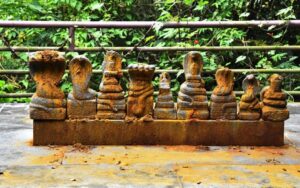 Nagaraja was very pleased with the offering, love and care of the couple that he appeared before them and said that he would incarnate as their son and stay at Mannarasala permanently in the form of a serpent. True to his words, Sreedevi became pregnant and gave birth to a five-headed serpent child and also a human child. Both the children grew up together. As time went by, Nagaraja asked his younger brother to get married for the perpetual preservation of the holy family and he obeyed him. Nagaraja, who realized that the objectives of his incarnation had been done, informed his mother that he would live at this home forever at the cellar. He then went to the cellar and after suggesting certain rituals and rules for offering worship, he vanished.
Nagaraja was very pleased with the offering, love and care of the couple that he appeared before them and said that he would incarnate as their son and stay at Mannarasala permanently in the form of a serpent. True to his words, Sreedevi became pregnant and gave birth to a five-headed serpent child and also a human child. Both the children grew up together. As time went by, Nagaraja asked his younger brother to get married for the perpetual preservation of the holy family and he obeyed him. Nagaraja, who realized that the objectives of his incarnation had been done, informed his mother that he would live at this home forever at the cellar. He then went to the cellar and after suggesting certain rituals and rules for offering worship, he vanished.
Devotees believe that the five-headed Nagaraja still stays in the cellar of the house, meditating for the prosperity of his descendants. Nagaraja gave certain instructions that only mother herself can offer worship to him and men are allowed only on certain days, before leaving for the cellar and he also instructed that after the mother’s time, the senior-most Brahmin lady in the family would have the status of the Mother. This is the main reason why the rituals of the Mannarasala Temple are carried out by a woman.
Festivals Celebrated in this temple
•Mannarsala Ayilyam:
As a serpent shrine, the Ayilyam of Thulam in the Malayalam Calendar which is popularly known as the Mannarasala Ayilyam. This is the major celebration of the Mannarasala Nagaraja Temple. It is celebrated with much religious fervor on the Ayilyam asterism in the Malayalam month of Thulam which roughly corresponds to the months of October and November.
The main attraction of this festival is the grand procession in which all the serpent idols in the sacred grove and the Mannarasala Temple are taken to the Illam (the Brahmin ancestral home) where special prayers and offerings like Nurum Palum (rice flour and milk) are performed. The chief priestess (Mannarasala Amma) will carry the golden idol of the main deity to the Illam.
Gnana Saraswati Temple is a Hindu temple of Goddess Saraswati located on the banks of Godavari River at Basara, Telangana, India. It is one of the two famous Saraswati temples in the Indian subcontinent, the other being Sharada Peeth. Saraswati is the Hindu Goddess of knowledge and learning. Children are brought to the temple for the learning ceremony called as Akshara abyasam.
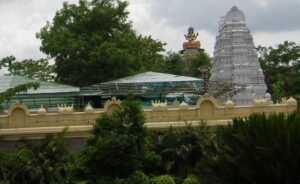 Basara is a census town in the Nirmal district in the state of Telangana. It is about 30 km (19 mi) from Bhainsa,15.5 km (10 mi) from Dharmabad, 34.8 km (22 mi) from Nizamabad, 96.0 km (60 mi) from Nanded, 70 km (43 mi) from district headquarters Nirmal, and 205 km (127 mi) from Hyderabad.
Basara is a census town in the Nirmal district in the state of Telangana. It is about 30 km (19 mi) from Bhainsa,15.5 km (10 mi) from Dharmabad, 34.8 km (22 mi) from Nizamabad, 96.0 km (60 mi) from Nanded, 70 km (43 mi) from district headquarters Nirmal, and 205 km (127 mi) from Hyderabad.
According to Mahabharatha, Maharishi Vyas and his disciples and sage Viswamitra decided to settle down in a cool and serene atmosphere after the Kurukshetra War. In the quest for a peaceful abode, he came to Dandaka forest and, pleased with the serenity of the region, selected this place. Since Maharishi Vyasa spent considerable time in prayers, the place was then called "Vasara" and turned into Basara due to the influence of the Marathi language in this region
It is also believed that this temple is one of the three temples constructed near the confluence of the Manjira and Godavari rivers.
Historically, 'Bijialudu' a Karnataka king, who ruled the province of Nandagiri with Nanded as his capital in the sixth century, constructed the temple at Basara. In the 17th century, the idols of the temple were reinstated by a chieftain of Nandagiri (Nanded) after the destruction caused by Muslim invaders.
Photo of the river Godavari, behind/adjacent to the temple, taken on 30 April 2011. Goddess Saraswati beside Godavari River Many pilgrims come to Gnana Saraswati Temple Basara to perform the "Akshara abhyasam" ceremony for the children before they start formal school education. The children perform the exercise of letters, and devote books, pens, pencils notebooks to the goddess of knowledge. The Puja at the temple starts at 4 am in the morning with Abhishekam which carries on for an hour. At 5 o'clock they start the Alankarana whereby the new sarees are adorned to the goddesses. The whole atmosphere is very pious and pure. At 6 am, in the rays of the morning sun, the aarti starts at the temple after which the prasadam is given to the devotees.
Special poojas and celebrations are held at the temple during MahaShivaratri, beginning 15 days before (Vasantha Panchami) and continuing 3 days after the festival. Devi Navarathrulu is celebrated for ten days during Dasara.
The temple also has a Mahakali idol situated on the 1st floor very near to the main temple. Devotees often go to the nearby mountain which has an Idol of Goddess Saraswati on the top of the rock. The image of Lakshmi stands beside the Goddess Saraswati in the sanctum sanctorum. Due to the presence of Saraswati, Lakshmi and Kali, Basara is considered as the abode of the divine trinity.
